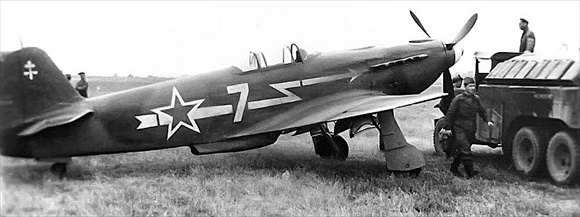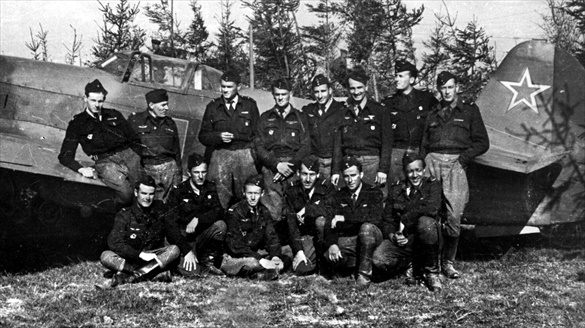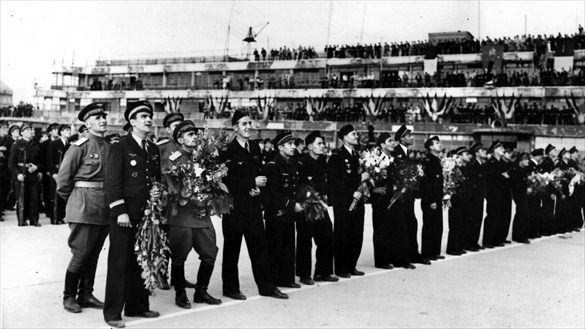FREE FRENCH FIGHTER PILOTS TO FLY WITH SOVIETS
Moscow, Soviet Union • November 28, 1942
On this date in 1942, while the Battle of Stalingrad was still being fought, 12 Free French fighter pilots and their ground crews, flying from newly liberated Syria in the Eastern Mediterranean, landed at their Ivanovo training center, 125 miles/201 km northeast of the Soviet capital, Moscow. Earlier in the year, in March, Gen. Charles de Gaulle, leader of the Free French government-in-exile, had ordered into being a new group of French fighter pilots and ground crew (Groupe de Chasse 3, or GC3, 3rd Fighter Group) and offered their services to Soviet leader Joseph Stalin to fight alongside the Soviet air forces. De Gaulle wanted Free French forces represented on every front of the war and Stalin was game enough. The administration of U.S. President Franklin D. Roosevelt had turned down a similar offer of services de Gaulle made after the Japanese attack on Pearl Harbor. The British, by contrast, were more than willing to accept de Gaulle’s offer. At least 7 Royal Air Force squadrons were entirely manned by Free French pilots, aircrew, and mechanics, and individual French aviators served in many other British or Commonwealth units.
Flying Soviet-built Yak fighters that sported the Soviet 1st Air Army star roundel and the French Normandy emblem, the Normandie Squadron (GC3, later reorganized into a regiment of 3 squadrons) saw its first combat mission in March 1943 when it flew escort for Soviet ground-attack bombers. On April 5, 1943, Normandie pilots had their first 2 kills. The next month, Field Marshal Wilhelm Keitel, chief of the Oberkommando der Wehrmacht (Supreme High Command of the German Armed Forces), signed an order that Normandie fighter pilots were to be shot if captured.
The French airmen scored impressive victories with the 1st Air Army in the epic Battle of Kursk (July 1943), when 2,000 Soviet planes engaged 1,800 German aircraft, and in the 1944 Soviet offensive in East Prussia. In one 2‑day period in mid-October 1944, the volunteer regiment, now grown to 50‑plus operational pilots, downed 38 German aircraft to 1 of their own. (The French pilot was rescued.) In 2 years of service, 42 of their number were killed (including 7 of the original 12) while over 30 became aces. Four were awarded the title of Hero of the Soviet Union. (Only 44 foreign citizens were awarded that title.) The Normandie-Niémen’s combat record of kills was the second highest in the Soviet air forces. Collectively they downed a confirmed 273 enemy aircraft with many more probables. During 5,240 missions they also destroyed 27 trains, 22 locomotives, and 154 trucks and staff cars as well as an unknown number of tanks and armored vehicles.
The Normandie-Niémen Regiment’s last campaign for the Soviets was clearing the skies of the remnants of the Luftwaffe during the battle for the German Baltic city of Koenigsberg in March and April 1945. The Frenchmen had stuck with the Soviet Union through thick and thin to the bittersweet end. As a reward for their faithful services, symbolic and insignificant in the grand scheme of the air war, Stalin presented 40 Yak‑3s to the French flyers to use in returning home. The Yaks formed the nucleus of France’s postwar air force.
Free French Normandie-Niémen Airmen on Eastern Front, 1942–1945
 |
Above: A Normandie-Niémen Yakovlev fighter, or Yak. The double-barred Cross of Lorraine, the symbol of Free France during World War II, has been painted on its tail. The accomplishments of the Normandie-Niémen Regiment, the only foreign division within the Red Army, are a source of great pride in France, and visitors can tour a museum at Le Bourget Airport in Paris that celebrates the airmen’s feats. The unit received numerous orders, citations, and decorations from both the Free French and Soviet governments, including the French Légion d’honneur, the Croix de guerre 1939–1945, and the Soviet Order of the Red Banner for conspicuous heroism, dedication, and courage demonstrated in battle. In 1944 Joseph Stalin awarded the unit the honorific name “Niemen” for its participation in the Battle of the Niemen (Neman) River, part of Operation Bagration, the great Soviet summer offensive against the German Wehrmacht (armed forces) in June and July 1944.
 |
Above: Normandie-Niémen pilots pose beside their Yak‑9 Soviet fighter, which was the squadron’s plane at the time. Roger Sauvage sits at far right in this photograph of Free French pilots. Sauvage (1917–1977), whose mother was a white Parisienne and whose father was a World War I soldier from Martinique in the French (Antilles) West Indies, was the highest scoring black fighter ace of World War II with 16 confirmed aerial victories and at least 1 probable. He was the recipient of 7 major Soviet and French decorations. The Normandie-Niémen Regiment was 1 of only 2 air combat units from an Allied West European country to participate on the Eastern Front during World War II, the other being the British No. 151 Wing RAF. The British pilots were stationed near the Soviets’ northern port of Murmansk during September–October 1941, providing air cover for Arctic merchant convoys and later pilot conversion training for Red Army Air Force pilots training on the Hawker Hurricane, the first Allied Lend-Lease aircraft to be delivered to the Soviet Union.
 |
Above: On June 20, 1945, at Paris-Le Bourget Airport, hundreds of thousands of people welcomed home the Normandie-Niémen heroes. Hero pilot 2nd Lt. Roger Sauvage, at over 6 ft/182 cm tall, is eighth from left in front row. In mid-1943, after the Western Allies had liberated Vichy French Algeria, Sauvage, a pilot in the Armée de l’air de Vichy, was given the choice of flying for the Royal Air Force or going to the Soviet Union, where he could join the Normandie squadron already famous for its role in the Battle of Kursk and its aftermath. He chose to hitch his fate to the Free French Normandie squadron. Along with 13 other French volunteer pilots, Sauvage arrived at Normandie’s airfield in Tula, 120 miles/193 km south of Moscow, on January 6, 1944.
French Film Tells the Story of the Normandie-Niémen Free French Airmen Who Fought on the Eastern Front from 1943 to 1945
![]()

 History buffs, there is good news! The Daily Chronicles of World War II is now available as an ebook for $4.99 on Amazon.com. Containing a year’s worth of dated entries from this website, the ebook brings the story of this tumultuous era to life in a compelling, authoritative, and succinct manner. Featuring inventive navigation aids, the ebook enables readers to instantly move forward or backward by month and date to different dated entries. Simple and elegant! Click
History buffs, there is good news! The Daily Chronicles of World War II is now available as an ebook for $4.99 on Amazon.com. Containing a year’s worth of dated entries from this website, the ebook brings the story of this tumultuous era to life in a compelling, authoritative, and succinct manner. Featuring inventive navigation aids, the ebook enables readers to instantly move forward or backward by month and date to different dated entries. Simple and elegant! Click 











